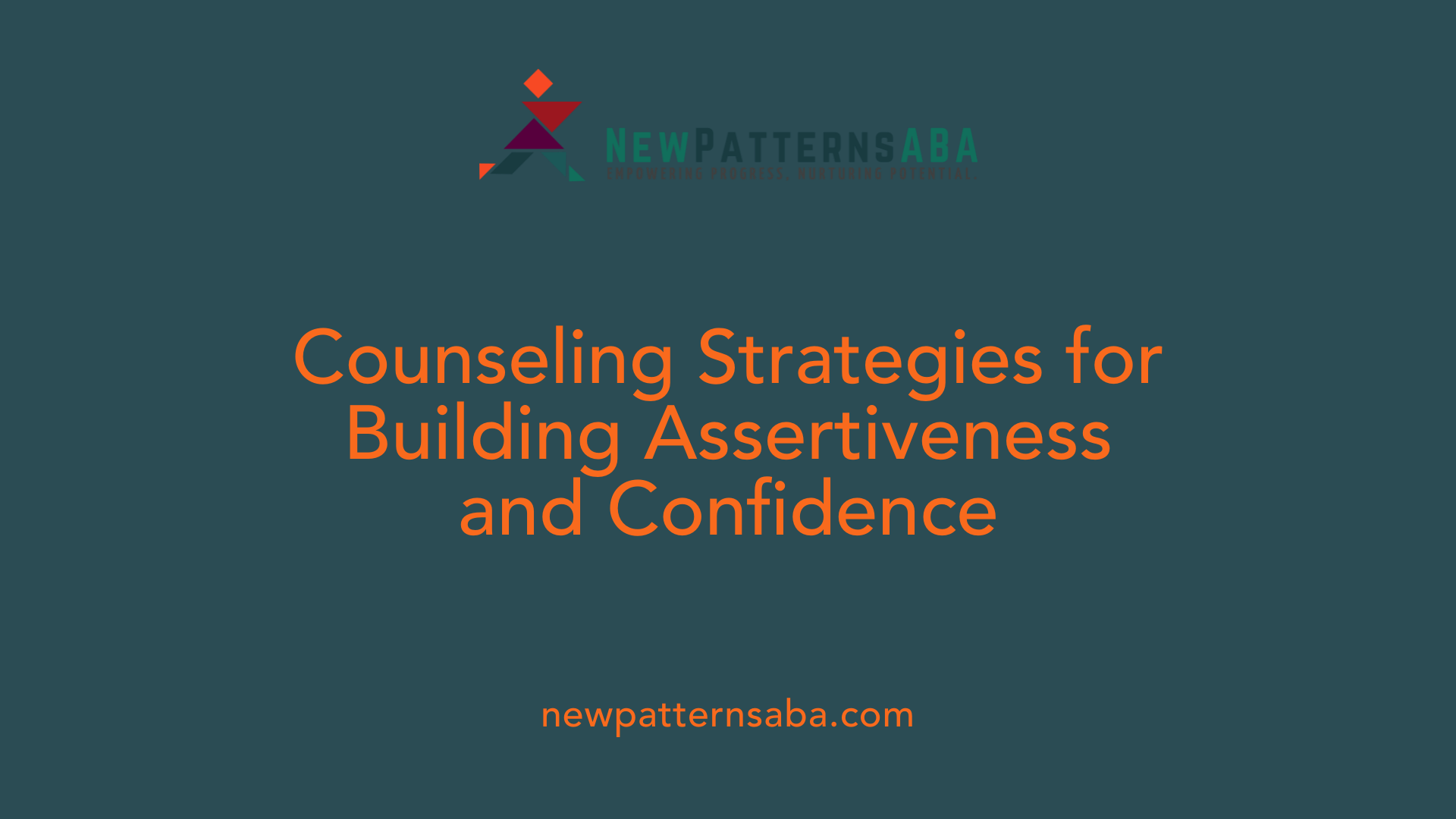Unlocking Social Potential Through ABA Therapy
Applied Behavior Analysis (ABA) therapy stands at the forefront of supporting children with autism and other developmental challenges in cultivating essential social skills. Among these, assertiveness—a vital attribute for healthy interaction, self-esteem, and emotional resilience—is a key focus. This article explores how ABA therapy promotes assertiveness, the strategies involved, and the broader benefits of nurturing this skill in children.
Core Principles of Assertiveness and Its Importance in Social Development

What is assertive training in behavior therapy?
Assertive training in behavior therapy is a structured approach designed to help individuals communicate more effectively. It focuses on teaching people how to express their thoughts, feelings, and needs clearly and honestly, while also respecting others. This type of training operates on the understanding that everyone has the right to voice their opinions without infringing on others' rights.
The process involves various techniques such as behavioral rehearsal and role-playing activities. These methods allow individuals to practice assertive responses in a safe environment. Specific strategies like the broken-record technique, where a person calmly repeats their point, and fogging, which involves accepting compliments or criticism without defensiveness, are also used.
Nonverbal behaviors are emphasized, including maintaining eye contact and good posture, to support verbal assertiveness. 'I' statements are encouraged to help articulate personal feelings without blame. Active listening plays a crucial role, enabling individuals to understand others' perspectives while asserting their own.
Overall, assertiveness training aims to boost confidence, lessen social anxiety, and foster healthier relationships. It is effective in reducing feelings of helplessness or frustration and is often incorporated into broader therapeutic approaches to enhance overall mental well-being.
How do assertiveness skills empower individuals to express their needs clearly while respecting others?
Building assertiveness skills helps individuals communicate their needs openly without being aggressive or passive. Using techniques like 'I' statements, people learn to express personal feelings directly, which reduces misunderstandings. Active listening ensures they acknowledge others' viewpoints, contributing to respectful exchange.
Regular practice of these skills improves confidence, making social interactions less stressful. It also helps individuals set and maintain boundaries, which are crucial for their emotional safety. When people feel empowered to speak up, they tend to experience higher self-esteem and greater control over their lives.
This balanced approach enriches relationships by fostering genuine understanding and openness. Respect for others’ rights and feelings is maintained, which creates a foundation of trust and cooperation. Therefore, assertiveness is not just about self-expression but about cultivating mutually respectful communication.
Benefits across various life domains
Assertiveness skills have positive implications in multiple areas of life. In academic settings, children who develop assertiveness are less likely to be bullied and more capable of expressing their boundaries.
In the workplace, assertiveness training correlates with reduced burnout and increased commitment to work responsibilities. Employees learn to advocate for themselves, ask for support, and handle conflicts constructively.
Socially, assertiveness enhances interpersonal relationships by enabling honest dialogue and fostering mutual respect. This contributes to relationship satisfaction and emotional well-being.
Psychologically, practicing assertiveness is linked to reduced depression and anxiety. It also promotes higher self-esteem and resilience.
In families and personal life, assertive communication helps in setting healthy boundaries and resolving conflicts effectively.
How does assertiveness training support children and individuals with specific needs?
For children, especially those with autism, developing social and assertiveness skills can be challenging due to difficulties with verbal expression, understanding non-verbal cues, or sensory overload.
Professional support from Registered Behavior Analysts (BCBAs) or Licensed Behavior Analysts (LBAs) practicing Applied Behavior Analysis (ABA) is often essential. They work with children to improve social skills using structured and individualized interventions.
Effective strategies include role-playing, social stories, and video modeling, which teach children how to initiate conversations, use eye contact, and practice empathy.
Parents are also involved, working alongside therapists to reinforce skills at home and during daily activities. Activities like social skills training and natural environment teaching help children generalize skills in real-world situations.
ABA techniques incorporate prompting, shaping, and reinforcement, which lead to meaningful improvements in communication and independence.
Counseling techniques, such as role-playing and active listening, teach children to understand their emotions and express themselves assertively. This supportive environment encourages confidence building and helps address fears related to social interactions.
Overall, with appropriate intervention, children with autism can develop essential social and assertive skills, boosting their overall development and ability to function independently.
How do strategies like ABA therapy and counseling integrate to enhance assertiveness?
ABA therapy aims to teach children functional communication skills through structured, evidence-based methods. By categorizing language into operants such as mands, tacts, echoics, and intraverbals, children learn to request, label, imitate, and respond in conversations. These skills are fundamental to assertiveness.
Assistive tools like AAC devices—picture exchange systems or speech-generating devices—support non-verbal children in expressing themselves. Positive reinforcement encourages children to practice using new communication behaviors.
Other techniques such as prompting, modeling, natural environment teaching, shaping, and chaining help children learn complex social and communicative behaviors systematically. These methods ensure skills are generalized across different settings.
Complementing ABA, counseling methods like role-playing and cognitive-behavioral techniques help children understand their emotions, recognize their rights, and develop problem-solving skills.
Counseling also provides a safe space for children to practice assertiveness, build self-esteem, and address fears like rejection or confrontation. Teaching about personal boundaries and consent furthers their understanding of appropriate social interactions.
Both approaches work together to promote healthier communication and social skills, ultimately supporting children’s independence and emotional well-being.
What activities help children with autism develop assertiveness?
Effective activities include role-playing, which allows children to practice social scenarios in a controlled setting.
Social skills training, such as initiating conversations and making eye contact, helps children build foundational skills in social interactions. Using social stories and video modeling further enhances understanding by illustrating expected behaviors.
Positive behavior-specific praise reinforces successful attempts and encourages continued practice.
Practicing play in social contexts gives children opportunities to engage with peers and develop assertiveness naturally.
Therapists often use visual aids and structured routines to teach concepts of personal boundaries and respect. For example, teaching about personal space and consent helps children understand physical boundaries.
Overall, consistent, structured practice through these activities can significantly improve autistic children’s ability to communicate confidently and assertively.
How can counseling support children in developing assertiveness?
Counseling provides a vital environment for children to learn, practice, and refine assertiveness skills. Techniques like role-playing simulate real-life situations where children can practice expressing their thoughts and feelings.
Building self-awareness through counseling helps children recognize their emotions and understand their rights, which is essential for assertiveness.
Counselors teach children how to express themselves effectively using verbal and non-verbal skills, including 'I' statements and active listening.
Addressing fears such as rejection or confrontation helps children become more comfortable with asserting themselves.
Counseling also supports confidence and self-esteem development, which are closely linked to assertiveness. When children believe in their ability to communicate and stand up for themselves, they become more likely to do so.
By promoting open communication and problem-solving skills, counseling enables children to handle conflicts assertively and reduce instances of bullying.
In summary, counseling creates a safe space for children to learn and practice assertiveness, empowering them to navigate social interactions more effectively.
Techniques and Strategies Used in ABA to Promote Assertiveness

What strategies and techniques are used in ABA therapy to promote assertiveness?
Applied Behavior Analysis (ABA) therapy incorporates a variety of methods to help children with autism develop stronger assertiveness skills. These techniques are designed to create structured, engaging ways for children to learn, practice, and generalize social and communication behaviors.
One fundamental approach is modeling assertive communication. By observing adult or peer examples, children learn how to express their needs clearly and respectfully. This visual cue helps children understand what assertiveness looks like in real-life situations.
Role-playing social scenarios is another essential technique. Therapists and parents simulate common social interactions, allowing children to practice assertiveness in a safe, controlled environment. Through repeated practice, children become more comfortable and confident in standing up for themselves.
Social stories and video modeling are powerful tools that provide visual narratives about social situations and appropriate responses. These methods help children understand what to do and say in various contexts, reinforcing their ability to communicate assertively.
Reinforcement systems such as praise, tokens, or access to preferred activities play a crucial role in encouraging children to display assertive behaviors. When children successfully use their communication skills or display confident social interactions, they receive immediate rewards, strengthening those behaviors.
To support independence, ABA therapy often uses scaffolding prompts—initial cues or assistance that gradually fade as the child gains confidence and mastery. This process helps children become more autonomous and less reliant on prompts for social interactions.
Additionally, ABA targets both verbal and nonverbal skills. This includes teaching eye contact, body language, understanding social cues, and appropriate tone of voice to ensure children can assert themselves effectively across various situations.
Overall, ABA strategies create a positive and engaging learning environment that promotes the development of assertiveness. The combination of modeling, practice, reinforcement, and gradual fading of support helps children become more confident communicators and social participants.
Tailoring Interventions to Individual Needs in ABA

How does ABA therapy support the development of assertiveness skills in children?
Applied Behavior Analysis (ABA) therapy plays a significant role in helping children develop assertiveness by providing personalized, structured approaches that focus on teaching social and communication behaviors. This therapy involves detailed assessments of a child's current social skills and assertiveness levels, which inform the creation of tailored goals.
During ABA sessions, therapists employ various techniques such as role-playing, social stories, and video modeling to teach children how to recognize social cues, interpret body language, and respond appropriately. These methods help children understand the dynamics of assertive communication and practice it in controlled settings.
Positive reinforcement is fundamental to ABA, rewarding children for using assertive behaviors, which increases the likelihood these behaviors will recur. Activities are designed to be enjoyable and engaging, making it easier for children to learn and apply new skills.
One essential aspect of ABA is the breakdown of complex social skills into smaller, manageable steps. For example, a child might first learn to initiate a conversation, then progress to expressing needs confidently, and eventually respond assertively to peer interactions. This step-by-step approach makes learning less overwhelming and allows for incremental mastery.
Naturalistic teaching strategies, including group interactions and peer modeling, promote real-world application of skills. These sessions simulate everyday social environments, helping children transfer learned behaviors outside therapy.
Collaboration with families and other caregivers is crucial. By involving parents and teachers, ABA plans are consistently implemented across different settings, reinforcing assertiveness skills and ensuring generalization to daily life.
Continuous assessment and data collection allow therapists to monitor progress and adapt interventions as needed. This personalized adjustment ensures that each child's unique needs are met, fostering greater confidence and effective communication in social situations.
In summary, ABA therapy supports assertiveness development through tailored, stepwise interventions that incorporate modeling, reinforcement, and real-world practice, all customized to the child's current abilities and goals. Such targeted therapy enables children to navigate social interactions more effectively and builds their confidence to express themselves assertively.
The Role of Positive Reinforcement and Natural Environment Teaching
How does therapy help children become more assertive?
Therapy plays a vital role in helping children develop assertiveness skills. It teaches specific communication techniques such as using 'I' statements, which allow children to express their feelings and needs clearly while respecting others. Active listening is another critical skill that therapy emphasizes, enabling children to understand and respond appropriately in social situations.
Structured therapy programs, including approaches like Cognitive-Behavioral Therapy (CBT) and Autism-focused interventions such as Applied Behavior Analysis (ABA), offer safe environments for practicing these skills. Activities like role-playing and modeling provide children with real-life scenarios to learn how to stand up for themselves and set boundaries without aggression or bullying.
Therapy doesn’t just improve communication; it also boosts self-confidence and reduces social anxiety. As children master these skills, they become more comfortable engaging with peers, teachers, and family members. They learn to manage criticism constructively and handle conflicts assertively, which can prevent issues like bullying and social exclusion.
Overall, effective therapy fosters a sense of empowerment. It helps children believe in their ability to express themselves confidently and respect the rights of others, fostering healthier relationships and better mental health.
Building Social Confidence with Role-Playing and Social Stories
What techniques and strategies are used in ABA therapy to promote assertiveness?
Applied Behavior Analysis (ABA) therapy employs a variety of methods to help children with autism develop assertiveness and improve their social skills. Central to this approach are modeling behavior, where children observe and imitate assertive actions. Role-playing social scenarios allows children to practice expressing their needs clearly and confidently in a safe, controlled setting.
Social stories and video modeling are also vital tools. These strategies provide visual and narrative frameworks for understanding social cues, personal boundaries, and appropriate responses in different situations. Reinforcement systems, such as praise, tokens, or access to preferred activities, motivate children to use their new skills.
Support from therapists involves scaffolding prompts—step-by-step guidance that gradually fades as children become more independent. This helps children feel more comfortable and confident in social interactions.
ABA also targets nonverbal skills like eye contact, body language, and understanding social cues, essential components for assertiveness. The overall goal is to create a positive and engaging environment where children learn to advocate for themselves effectively.
How can role-playing exercises and social stories boost social confidence?
Role-playing exercises simulate real-life social situations, giving children the chance to practice standing up for themselves, setting boundaries, and expressing their feelings. These exercises can involve scenarios like asking for help, saying no, or initiating a conversation, helping children develop the confidence needed for everyday interactions.
Social stories are personalized narratives that describe social situations, expected behaviors, and appropriate responses. They help children understand what to do in specific contexts and reduce anxiety caused by uncertainty.
Video modeling often complements these strategies by showing children peer examples of successful social interactions. This visual approach enhances learning, making abstract social concepts more concrete.
Together, role-playing and social stories build a child's self-awareness, reinforce positive behaviors, and promote consistency across different settings.
| Technique | Purpose | How It Works |
|---|---|---|
| Role-playing | Practice social responses | Children act out real-life scenarios, gaining confidence |
| Social stories | Understand social norms | Narratives teach about boundaries, feelings, and behaviors |
| Video modeling | Visual learning | Children observe peers demonstrating appropriate interactions |
More about role-playing and social stories in ABAs
For additional insights, searching for "role-playing and social stories in ABAs" reveals their importance in structured interventions. These strategies are supported by evidence suggesting they significantly improve social functioning and assertiveness in children with autism.
In summary, integrating role-playing exercises and social stories within ABA therapy serves as powerful tools to nurture assertiveness, reduce social anxiety, and foster independence for children navigating the social world.
Fostering Generalization of Assertiveness Skills in Natural Settings
How does therapy help children become more assertive?
Therapy plays a crucial role in helping children develop and generalize assertiveness skills, making these abilities useful in everyday life. It primarily teaches children specific communication techniques like using 'I' statements and practicing active listening. These methods allow children to express their needs clearly and respectfully while considering others.
Structured therapy sessions—such as those guided by professionals like Board-Certified Behavior Analysts (BCBAs) or Licensed Behavior Analysts (LBAs)—often incorporate behavioral interventions like Applied Behavior Analysis (ABA). These programs use activities such as role-playing, modeling, and cognitive restructuring to create a safe space for children to practice new skills.
Role-playing exercises are particularly effective because they simulate real-world interactions, enabling children to rehearse responses in a controlled setting. This practice helps build confidence and reduces social anxiety, making children more comfortable and assertive in actual social situations.
Therapeutic techniques also include teaching children to handle criticism and evaluate their behavior, fostering authenticity and self-awareness. Children are encouraged to set personal social goals, which are steadily practiced and reinforced.
Another important aspect of therapy involves boosting self-esteem and resilience. As children see their progress and become more confident in expressing themselves, they are less likely to feel overwhelmed or anxious about social interactions.
Overall, therapy helps children become more assertive by empowering them with practical skills, creating opportunities to practice, and supporting their emotional growth. This process enables children to navigate social environments with greater ease, protecting them from bullying and conflicts while promoting mental well-being.
Through consistent therapy practices, children not only learn how to communicate better but also develop the ability to handle complex social situations independently, laying a foundation for healthier relationships and improved overall quality of life.
The Role of Counseling in Enhancing Assertiveness

How does therapy help children become more assertive?
Counseling plays a vital role in helping children develop assertiveness skills by teaching them effective ways to communicate their needs and boundaries. Therapists often focus on core techniques like using 'I' statements, which allow children to express feelings from their perspective without sounding accusatory. Active listening is another fundamental skill taught, helping children understand others better and respond appropriately.
Structured therapy sessions, including approaches like cognitive-behavioral therapy (CBT) or specific assertiveness training, offer a safe space for children to practice these techniques. Tools such as role-playing enable kids to simulate real-life social interactions, making them more comfortable and confident in expressing themselves.
Building self-confidence and self-esteem is a central goal of therapy. When children achieve a sense of mastery in social situations, their fears and anxieties about rejection or confrontation diminish. Consistently, therapy fosters empowerment by encouraging children to stand up for themselves and respect others.
Through cognitive restructuring, children learn to challenge unhelpful beliefs about their worth or fears of negative reactions, enhancing their authentic self-image. Therapists also model assertive behavior, providing children with practical examples they can emulate.
Furthermore, addressing anxieties associated with social interactions helps children feel more at ease. When children learn to manage their fears effectively, they become more willing to participate in social activities, reducing stress and improving overall mental health.
In addition to skill-building, counseling promotes problem-solving abilities and resilience. Children become better equipped to navigate conflicts, peer pressure, and bullying in a respectful yet firm manner.
Overall, therapy nurtures a child's sense of agency and safety, creating the foundation for lifelong assertiveness. As children grow more confident in their communication, they discover that their needs and boundaries are valid, which profoundly improves their social relationships and mental wellbeing.
The Broader Impact of Developing Assertiveness Skills

How does assertiveness training reduce bullying?
Building assertiveness skills equips children with the confidence to express themselves clearly and stand up for their boundaries. When children know how to communicate their needs assertively, they are less likely to be taken advantage of or manipulated, reducing their chances of being bullied. Developing these skills also helps children recognize and respond to bullying behavior effectively, fostering a safer social environment.
In what ways do assertiveness skills improve relationships?
Assertiveness is fundamental in creating healthy relationships, whether with family, friends, or colleagues. It encourages open, honest communication that respects both one's own needs and those of others. Techniques like using “I” statements and active listening promote understanding and trust. Regular practice enhances confidence, making interactions smoother and more satisfying.
Can assertiveness training contribute to better mental health?
Absolutely. Learning to communicate assertively contributes to lower levels of depression and anxiety by empowering individuals to express their feelings and set boundaries. It also boosts self-esteem and relationship satisfaction, which are essential for overall psychological wellbeing. For many, developing these skills is a vital step toward greater resilience and emotional stability.
The role of ABA therapy in teaching social and assertiveness skills to children
Applied Behavior Analysis (ABA) therapy plays a crucial role in improving social and assertiveness skills in children with autism. ABA therapists work closely with children, guiding them on how to navigate social situations with confidence. Their structured, individualized interventions help children become more comfortable and less overwhelmed in social settings, which is vital for their development.
Benefits of ABA therapy in enhancing children's assertiveness abilities
ABA therapy significantly enhances communication and social skill development in children with autism spectrum disorder. Its structured approach targets speech, language comprehension, and social cues, helping children express themselves more effectively. This not only improves their ability to assert their needs but also supports their overall development and independence.
| Technique | Description | Benefits |
|---|---|---|
| Social Skills Training | Activities like role-playing, video modeling, and social stories | Builds confidence, improves communication, reduces social anxiety |
| ABA Interventions | Methods like prompting, shaping, and natural environment teaching (NET) | Teaches complex skills, promotes generalization in real-life settings |
| Communication Devices | Use of AAC tools such as speech-generating devices or picture exchange | Assists non-verbal children in effective communication |
| Reinforcement Strategies | Positive reinforcement to encourage desired behaviors | Increases use of communication and assertiveness skills |
How counseling supports developing assertiveness skills
Counseling techniques such as role-playing, active listening, and cognitive-behavioral methods help children understand and express their emotions better. These strategies build self-awareness, address fears related to rejection or confrontation, and teach problem-solving skills. Counseling also offers a safe space for practicing assertiveness, thus boosting confidence and reducing anxiety.
Clarifying boundaries and personal space
Teaching children about boundaries, personal space, and consent is a crucial component of assertiveness training. These lessons help children understand their rights and how to respect others, fostering healthy interactions. Proper boundary setting also reduces misunderstandings and conflicts, contributing to a more positive social environment.
Addressing fears and promoting emotional resilience
Many children, especially those with social challenges, face fears of rejection and confrontation. Counseling helps address these anxieties by teaching coping skills and challenging unhelpful beliefs. Developing resilience through these methods encourages children to communicate openly and assertively, even in difficult situations.
Impact on overall development and independence
When children develop strong assertiveness skills, their overall social and emotional development accelerates. They become more independent, capable of handling social interactions confidently, and better equipped to manage conflicts and balance their needs with those of others. This foundation supports lifelong positive relationships and mental health, underscoring the importance of early assertiveness training.
Empowering Future Social Success
Fostering assertiveness through ABA therapy not only enhances children's communication skills but also equips them with the confidence to navigate social environments, resist bullying, and build meaningful relationships. As they develop these crucial skills, children gain independence and resilience, setting the stage for successful social integration and well-being in the future.
References
- How to Teach Assertiveness Skills in Therapy: 5 Techniques
- Autism and Social Skills: Helping Your Child Thrive
- How ABA Therapy Can Improve Communication Skills in Children
- How to Teach a Child to Be Assertive Counseling?
- Morning Star ABA Therapy Social Skills Training
- Applied Behavior Analysis (ABA) | Autism Speaks
- How ABA Therapy Enhances Social Skills in Children with ASD





